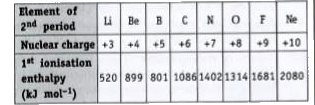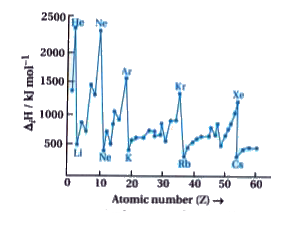Define ionisation enthalpy. Discuss the factors affecting ionisation enthalpy of the elements and its trends in the periodic table.
Text Solution
Ionisation enthalpy: The minimum amount of energy required to remove the most loosely bound electron from an isolated gaseous atom so as to convert it into a gaseous cation is called its ionisation enthalpy. It is represented by ΔH.
Factors affecting ionisation enthalpy of the elements: It depends upon the following factors:
(1) Nuclear charge : As Nuclear charge increases ionization enthalpy increases.
This due to the fact as with increase in nuclear charge, the electrons of the outer shell are more tightly bonded by the nucleus and thus more amount of energy is required to taken out that electron from atom.
e.g., The ionisation enthalpy increases as we go from left to right due to increase in nuclear charge.

(ii) Atomic size or radius : As the size of atom increases, ionisation enthalpy decreases. Distance between outer electron and nucleus increases with increase in atomic radius, the attractive force on the outer electron decreases.
As a result, outer electron are held less bonded and hence less amount of energy is required to to take off that electron.
Thus, ionisation enthalpy decreases with increase in atomic size. Ionisation enthalpy is found to decrease on moving from top to bottom in a group.

(iii) Penetration effect of the electrons : As penetration effect of the electrons increases the ionisation enthalpy increases.
It is well known fact that in case of multi electron atoms, the s-orbital electrons possibility are maximum found near the nucleus and this probability goes on decreasing in case of p, d and f-orbitals of the same shell.
s-electrons of any shell are more nearer to the nucleus than p-electrons.
The order of penitration effect decreases in the order s>p>d>f.
e.g., First ionisation enthalpy of aluminium is lower than that of magnesium. This is due to the fact that in case of aluminium (1s22s22p63s23p1x), we have to pull out a p-electron to form Al+ ion whereas in case of magnesium (1s22s22p63s2) we have to remove an s-electron of the same energy shell to produce Mg+ ion.
(iv) Shielding or screening effect of inner shell electrons : Ionisation enthalpy decreases when their is shielding or the screening effect of the inner electrons increases.
Attraction between nucleus and valence shell electrons decreases and hence the ionisation enthalpy decreases.
(v) Effect of arrangement of electrons : If an atom contains exactly halfly filled orbitals or fully filled orbitals then such an arrangement has extra stability.
Therefore, the removal of electron from such an atom requires more energy than expected.
e.g., Be (1s22s2) has higher ionisation enthalpy than B (1s22s2)andN(1s22s22p6x2p6y2p1y2p1z) has higher ionisation enthalpy than O (1s22s22p2x2p1y2p1z). In general, as we move from left to right in a period, the ionisation enthalpy increases with ncreasing atomic numbers.
The ionisation enthalpies keep on decreasing regularly as we move down a group from one element to the other.

Variation of first ionisation enthalpies (ΔiH) with atomic number for elements with Z = 1 to 60
|
Topper's Solved these Questions
- CLASSIFICATION OF ELEMENTS AND PERIODICITY IN PROPERTIES BOOK - KUMAR PRAKASHANCHAPTER - CLASSIFICATION OF ELEMENTS AND PERIODICITY IN PROPERTIES EXERCISE - Section -D SOLUTIONS OF NCERT EXEMPLAR PROBLEMS (Assertion and Reason )
3 Videos
- CHEMICAL BONDING AND MOLECULAR STRUCTUREBOOK - KUMAR PRAKASHANCHAPTER - CHEMICAL BONDING AND MOLECULAR STRUCTUREEXERCISE - SECTION -D (SOLUTIONS OF NCERT EXEMPLAR PROBLEMS) (LONG ANSWER TYPE QUESTIONS)
10 Videos
- ENVIRONMENT CHEMISTRY BOOK - KUMAR PRAKASHANCHAPTER - ENVIRONMENT CHEMISTRY EXERCISE - Question For Module (Section-C)
1 Videos
Similar Questions
Knowledge Check
The second ionisation enthalpy of an element M is the energy required to
Aremove one mole of electrons from one mole of gascous cations of the elementBremove one mole of electrons from onc mole of gaseous anionsCremove one mole of electrons from onc mole of monovalent gascous cations of the elementDremove 2 moles of electrons from one mole of gaseous atoms.The trend in ionisation enthalpy of transition element is not regular because
ARemoval of one electron alters the relative energies of 4s and 3d orbitals.BDue to different E.C. ( stability )CPoor screening of 3p orbitalDBoth(1) & (2)
Discuss the factors affecting electron gain enthalpy and the trend in its variation in the periodic table.
View SolutionDiscuss the factors affecting electron gain enthalpy and the trend in its variation in the periodic table.
View SolutionState the factors which influence or affect the ionisation potential of elements in a periodic table.
View SolutionPeriodicity In Ionisation Enthalpy
View SolutionThe trend in ionisation enthalpy of transition element is not regular because
View SolutionThe trend in ionisation enthalpy of transition element is not regular because
View Solution
